Smart Glass Opens a Window to New Applications
The earliest evidence of glass-making dates back an estimated 4,000 years ago to ancient Mesopotamia. Called “humankind’s most important material,”1 glass is everywhere in our modern environment—encasing skyscrapers, letting light into our homes, providing an integral substrate for smartphones and electronic devices, as prescription lenses that help us see better, the windshields on our vehicles, and the fiber optic cables that connect the world.
Recent decades have seen a proliferation of new glass-based technologies such as touchscreens and ultra-thin flexible glass for the newest foldable devices. Innovations in “smart glass” fabrication are now taking the material to the next level, as technology advancements and the parallel trends of digitization and displays are helping to create more dynamic glass applications.
What is Smart Glass?
Essentially, smart glass is fabricated with special layers or coatings that provide functional characteristics. These functions can include:
- Adjustable tint – some types of smart glass automatically respond to sunlight or are controlled electronically to change from transparent to tinted or opaque.
- Heat & noise blocking – Various treatments of smart glass enable windows in houses or automobiles to lower heat transmission and reduce noise.
- Displays – Smart glass with an embedded electrical layer can be used to display images or serve as an interactive touchscreen.
- Solar power collection – embedding photovoltaic cells within layers of glass makes it possible for a vehicle sunroof to double as a power source to supplement battery power.
Not to be confused with “smart glasses”—the augmented-reality devices worn on our heads—smart glass is finding broad application in industries such as architecture, aerospace, and automotive. The earliest smart glass products were Transitions® eyeglasses that change from clear to tinted when a wearer steps into the sun. The photochromic glass used in this application was first commercialized in the 1960s.
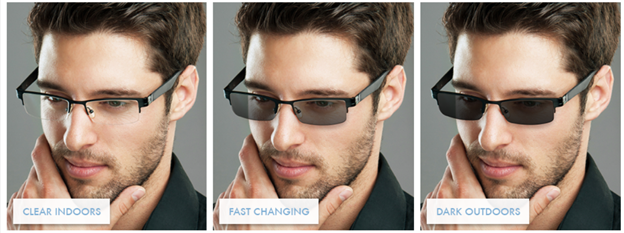
Adjustable-tint photochromic glass lenses used in Transitions® progressive eyeglasses. (Image Source)
Two industries that have rapidly adopted smart glass are architecture and construction. In both residential and commercial buildings, adjustable smart glass confers multiple benefits. Reducing UV and sunlight entering a building helps keep it cooler, reducing the need for air conditioning thus saving energy and lowering the carbon footprint.
Blocking the sun's glare not only makes occupants more comfortable, but also reduces long-term damage to furniture, fabrics, and objects. For example, museums are benefitting from smart-glass sunroofs that provide bright, natural light optimal for viewing artwork while blocking glare and damaging UV rays. In addition to exterior windows and doors, smart glass can also be used for internal doors and partitions to provide privacy and instantly transform a space while occupying a smaller footprint than walls.
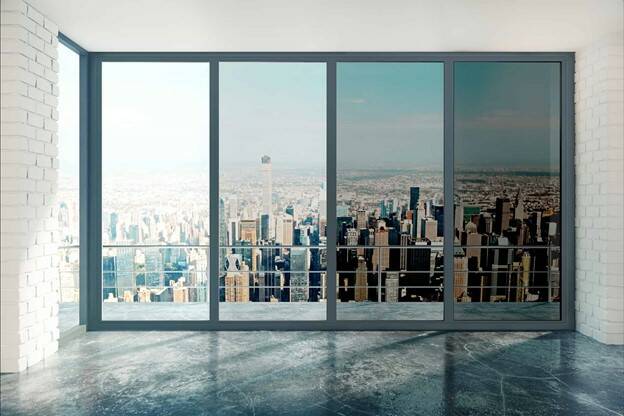
Example of progressively darker tint on architectural glass that uses electrochromic technology (Image © Halio)
In the transportation industry, many aerospace, marine, and automotive manufacturers have also been quick to incorporate smart glass into planes, boats, and vehicles. Adjustable-tint windshields can automatically adapt to ambient light conditions to improve visibility and safety. Heat-blocking windows and sunroofs reduce the need for air conditioning and its components, lowering fuel consumption and emissions.
Smart glass is especially attractive to electric vehicle (EV) makers. “Tests show that SPD-SmartGlass can reduce fuel consumption and increase the driving range of electric vehicles by up to 5.5%, reduce CO2 emissions by 4 grams/km, block 95% of heat, and reduce temperature inside vehicles by up to 18ºF/10ºC.”2
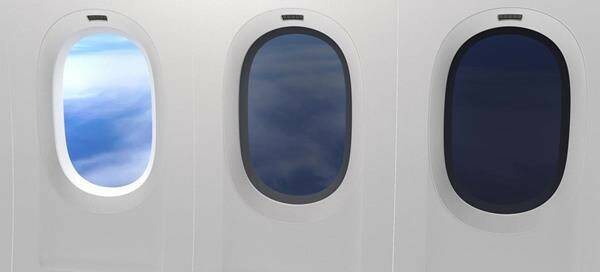
Electrochromic glass from Gentex is used in the Boeing 777 to block sunlight and heat, allowing passengers to selectively dim their windows. (Image © Gentex)
Smart glass is also emerging as a display technology. Unlike traditional displays where a glass screen lies in front of a panel that generates digital images (such as an LCD), some types of smart glass can generate a display image from within the glass layers while preserving transparency. For example, some automakers are working on passenger windows that can be touchscreen infotainment displays, and retailers are investing in store windows that serve as a dynamic marketing panel. With so many current and potential uses for smart glass, the market is predicted to grow to nearly $16 billion globally by 2027, a 17.2% CAGR,3 with the architectural and automotive market segments leading the way.
Demonstration of a smart retail window that can display promotional messages and videos, or return to a transparent state, all to draw in more shoppers.
How Does Smart Glass Work?
Fundamentally, smart glass is fabricated with specialized functional or “active” interlayers like films, liquid crystal, and electronics that are sandwiched between two outer layers of glass. This composition can also include adhesive layers, spacing, laminates, and coatings. Different types of active layers or layer combinations result in a wide range of capabilities, allowing smart glass to serve many functions.
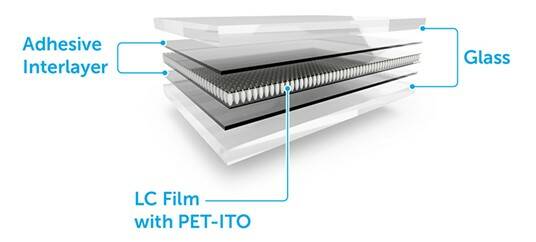
An example of smart glass consisting of an active layer (liquid crystal film) and adhesives sandwiched between two thin outer layers of glass. (Image © Gauzy)
Types of Smart Glass
Smart glass technologies fall into two categories—passive and active. In passive technologies, the functional layer is either light-sensitive (photochromic) or heat-sensitive (thermochromic). They are called passive because they respond automatically to changes in the sun’s UV rays or radiant heat. There is no electrical charge needed, but changes to tint or opacity cannot be controlled by a user.
Active smart glass technologies, on the other hand, respond to electric current thanks to a conductive layer which enables functions to be controlled or adjusted by the user. Electrified smart glass offers additional capabilities such as emitting light, acting as a display screen, enabling variable settings or patterns across a glass panel, or even collecting solar power. Active technologies are broken down into electrochromic, polymer dispersed liquid crystal (PDLC), and suspended particle device (SPD).
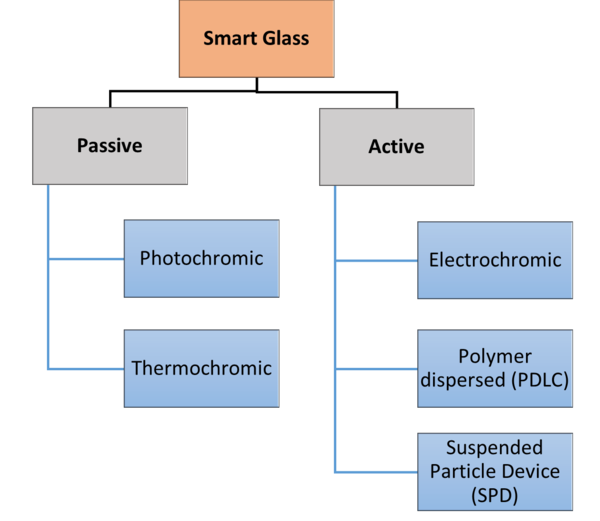
The smart glass category includes both passive and active technologies.
Photochromic Glass. Photochromic smart glass (the technology used for Transitions® eyewear) uses a layer of film with photo-sensitive molecules laminated to the inner or outer surface of the glass. The molecules are invisible until exposed to UV rays, which cause them to react (change structure) and change transmittance (change the amount of light let through) going from clear to darker. The amount of tint depends on the amount of UV—the glass adapts to different light conditions. When UV is gone, the glass changes back to transparent.
Thermochromic Glass. Thermochromic smart glass is commonly made with an interlayer of polyvinyl butyral (PVB) sandwiched between glass layers. When sunlight or radiant heat strikes the glass, it darkens progressively as the temperature rises. Different materials, such as ceramic coatings, are layered on the inner surface of glass, which trap the heat within the thermochromic layer, keeping it cool inside a building or vehicle. As an added bonus, these layers can also block noise.

Thermochromic glass in production with a PVB layer sandwiched between two glass layers. (Image © Sekisui)
Electrochromic Glass. Electrochromic materials change color when electrical current is applied. For this type of smart glass, an electrochromic layer is sandwiched between glass and conducting layers. Applying a charge activates ions in an electrolyte layer, which causes the electrochromic layer to change from dark (or opaque) to transparent.
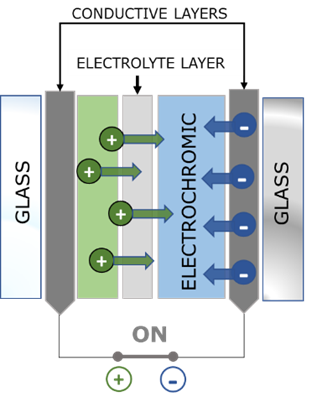
Schematic of electrochromic smart glass structure.
The glass stays clear on its own; additional electric power is needed only to switch back. Previously the transition from clear to opaque had been slow, but recent advancements have reduced the switching time to just 2 seconds. Electrochromic glass also has noise blocking properties.
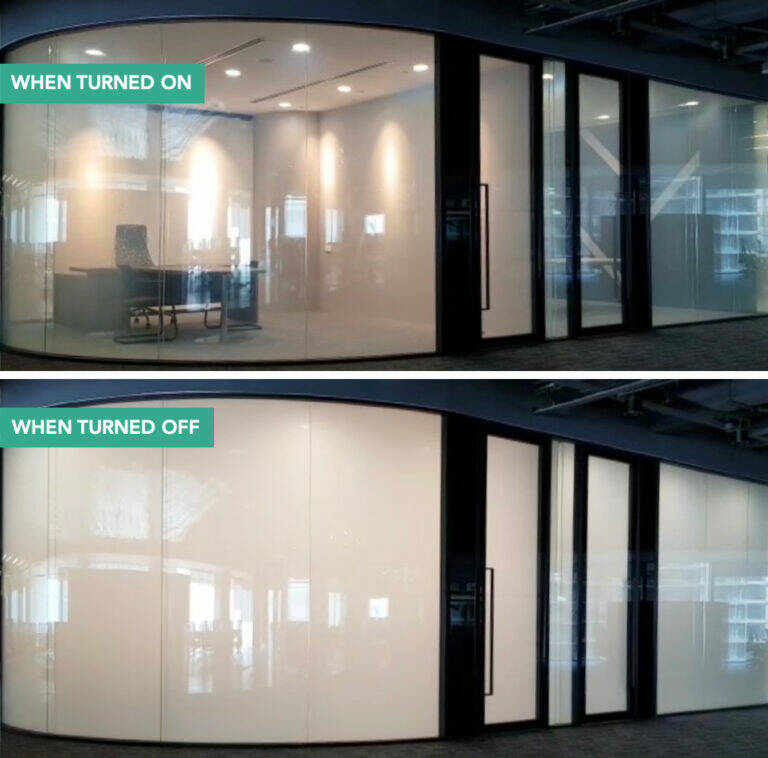
Electrochromic switchable partition in an office (Image Source).
Suspended Particle Device (SPD). SPD glass has a layer of particles between two conductive layers. When the conductive layers are activated with an electrical charge, the particles align, allowing light to pass through. In its inactive (dark) state, SPD glass blocks up to 99% of light.
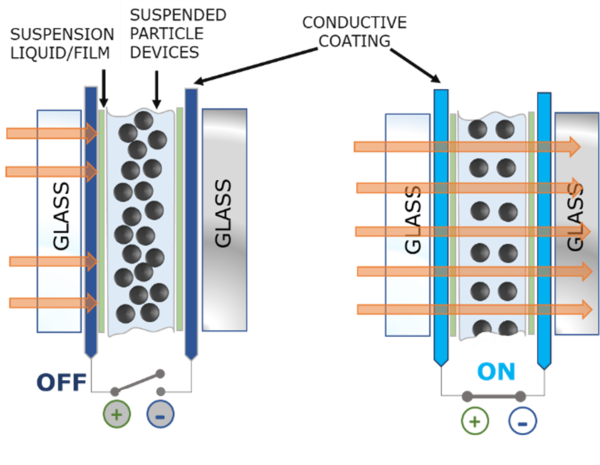
Schematic of suspended particle device (SPD) smart glass, in the off and on states.
Polymer Dispersed Liquid Crystal (PDLC). PDLC technology uses a layer of LCD crystals sandwiched between conductive layers. Like electrochromic and SPD glass, its default off state is opaque. When an electric current is applied, the crystals align in parallel, becoming transparent and allowing light through.

Schematic of Polymer Dispersed Liquid Crystal (PDLC) smart glass, in the off and on states.
Quality Considerations for Smart Glass Applications
Makers of smart glass and the products that use it must consider multiple factors to ensure quality. The first consideration is the quality of the formation and composition of the glass itself. Glass manufacturers must watch for a variety of quality issues including:
- Optical faults – defects in the glass structure leading to issues like warping, or image distortion (when used for displays)
- Spot faults – such as bubbles and deposits within the glass
- Linear or extended faults – surface scuffs or scratches
- Lamination defects – when sheets of glass are laminated together with various functional and electrical layers, adhesives, and films, dust particles may become trapped or bubbles between layers can interfere with the visual quality of the glass.
Important quality considerations for adjustable-tint and adjustable-opacity smart glass are uniformity in appearance and transmittance (the amount of light passing through). Transitions between transmittance levels (for example, from clear to dark) should appear even and seamless. Manufacturers need to determine if tint or opacity appears the same across the entire glass sheet, if the correct amount of light is blocked or passed through, and if the tint is the correct color.
In this measurement image (shown in false color scale), light differences are evident in the center and along the bottom and corners of this panel, indicating poor uniformity. Image from Radiant’s TrueTest™ Software.
When smart glass is used for displays, additional quality considerations are added to the list, including luminance, clarity, shape, and orientation of virtual images, as well as their contrast or visibility against the ambient environment visible through the glass surface. For some smart glass display applications, image elements can be less than a millimeter in size, so these must be measured with precision. Used with displays, curved glass creates an additional challenge for accurate optical measurement.
Optical Measurement Solutions
Optical measurement systems can be used to quantify visual properties of the glass, including values of light such as luminance, chromaticity, uniformity, and contrast for detecting transmittance of glass at various stages of opacity. Light values can also be used to determine the sharpness or MTF (modulation transfer function) of illuminated regions like icons on a display, or to identify hot spots and darks spots across tinted or illuminated glass.
Detecting particles and lines in films or layers, evaluating the completeness of display symbols and shapes, and characterizing glass effects such as image distortion, warping, and ghosting—these tasks all require a spatial understanding of visual qualities of the glass. A smart glass test system must have the capability to measure values and detect elements—and measure them in their actual spatial positions.
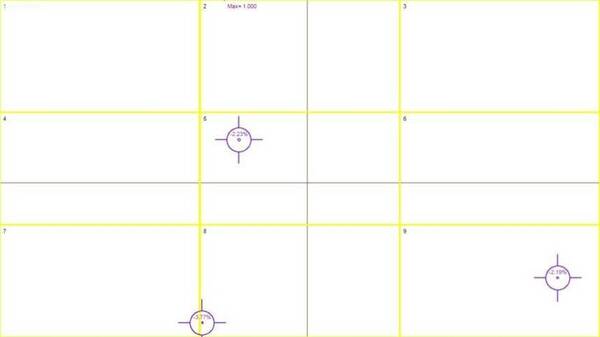
Random defects identified on a panel using TrueTest™ Software.
For this, an imaging photometer or colorimeter is needed to capture high-resolution data for precise detail analysis and measure absolute values of luminance and chromaticity. Just as critical is image processing and analysis software, which should offer specific algorithms for measuring these values and analyzing glass characteristics.
Radiant’s ProMetric® Imaging Photometers and Colorimeters capture a full field of view of the measurement area to efficiently characterize all important criteria in the glass at once. Special optical filters and calibrations ensure that light is weighted against standard CIE functions describing the human visual response. This way, smart glass is evaluated according to its brightness, color, and quality as perceived by building inhabitants, vehicle occupants, display viewers, and device users.
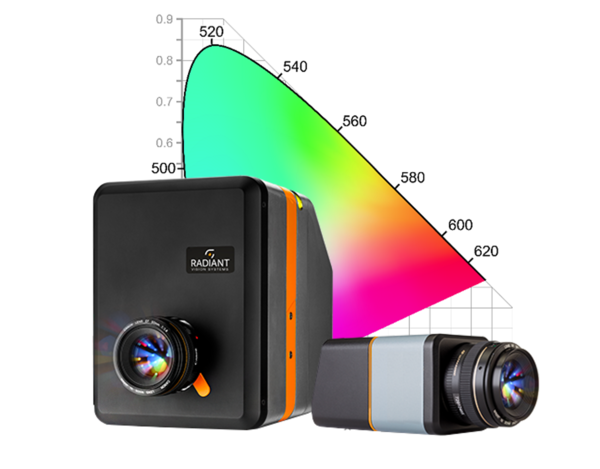
A ProMetric Imaging Colorimeter (left) and Photometer (right) engineered to simulate human visual perception of light and color.
CITATIONS
- Mann, T., “Humankind’s Most Important Material,” The Atlantic, April 7, 2018.
- “Two New Uses for Research Frontiers’ SPD-SmartGlass Technology Produced by Gauzy Lt. Unveiled at the IAA Munich Auto Show This Week. Research Frontiers, September 8, 2021.
- Smart Glass Market Size, Share…Forecast, 2020-2027, Fortune Business Insights, September 2020.
Join Mailing List
Stay up to date on our latest products, blog content, and events.
Join our Mailing List
